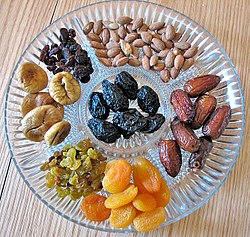
Back فاكهة جافة Arabic मेवा AWA Сухафрукты Byelorussian Suho voće BS Fruita dessecada Catalan Lubi CEB وشکەبەر CKB Sušené ovoce Czech Trockenobst German Seka frukto Esperanto
| Dried fruit | |
|---|---|
 Dried fruit and nuts on a platter | |
| Origin | Mediterranean, Mesopotamia, India |
| Use | Preservation of fruit for use as food |
| Production | Earliest: Dates and raisins |
Dried fruit is fruit from which the majority of the original water content has been removed prior to cooking or being eaten on its own.[1] either naturally, Drying may occur by sun, through the use of industrial dehydrators, or by freeze drying.[2] Dried fruit has a long tradition of use dating to the fourth millennium BC in Mesopotamia, and is valued for its sweet taste, nutritional content, and long shelf life.
In the 21st century, dried fruit consumption is widespread worldwide. Nearly half of dried fruits sold are raisins, followed by dates, prunes, figs, apricots, peaches, apples, and pears.[3] These are referred to as "conventional" or "traditional" dried fruits: fruits that have been dried in the sun or in commercial dryers. Many fruits, such as cranberries, blueberries, cherries, strawberries, and mango are infused with a sweetener (e.g., sucrose syrup) prior to drying. Some products sold as dried fruit, like papaya, kiwifruit and pineapple, are most often candied fruit.
- ^ Oxford English Dictionary, "dried fruit", 3rd ed., Oxford University Press, 2010. Accessed November 21, 2024. https://www.oxfordlearnersdictionaries.com/definition/english/dried-fruit
- ^ Herringshaw, Dorris. "Drying Fruits and Vegetables | Ohioline". Ohioline. Retrieved 21 November 2024.
- ^ Hui, Y. H. Handbook of fruits and fruit processing. Blackwell Publishing, Oxford UK (2006) p. 81